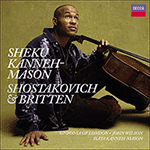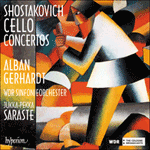
Welcome to Hyperion Records, a British classical label devoted to presenting high-quality recordings of music of all styles and from all periods from the twelfth century to the twenty-first.
Hyperion offers both CDs, and downloads in a number of formats. The site is also available in several languages.
Please use the dropdown buttons to set your preferred options, or use the checkbox to accept the defaults.

By this time, Shostakovich’s international reputation was assured, but he was in failing health. A recent serious heart attack, followed by long convalescence in Crimea after extensive hospitalization, caused the lifelong cigarette smoker to curtail his activities significantly.
Although Shostakovich’s compositional capabilities were unimpaired, as the new concerto demonstrated—it was written in Yalta within a month—the rate of his output slowed as its emotional content deepened. He explained that the second concerto began as a memorial piece for the poetess Anna Akhmatova, who had died in March 1966, aged seventy-six, having been nominated for the Nobel Prize the year before. Shostakovich described her as ‘the queen of Russian poetry’.
The mood, therefore, of the concerto is essentially reflective, allied to remarkable passages of naive and direct expression. The soloist is partnered by a very large, not to say unique, orchestra: double woodwind and contrabassoon, two horns, timpani, large percussion section, at least sixty-four strings, and a minimum of two harps—the harps always in unison. Apart from the consistently distinctive sound of the orchestra, Shostakovich uses his forces sparingly; only in one or two passages, literally, does he call on his full forces, to astoundingly dramatic and expressive effect. Indeed, a listener, not knowing the composer’s full instrumentation, might well be forgiven for imagining that the work is scored for a chamber orchestra. Here, surely, is a convincing demonstration of Mahler’s influence on Shostakovich. However, the work (much more than the direct utterance of the first concerto) makes considerable technical and interpretative demands on soloist, conductor and (not least) orchestra.
The first movement opens in reflective vein. Throughout the concerto there is an overriding nostalgic element, a contemplation of things past, as in a reflective brown study. There are allusions to earlier works of the composer—not in the direct manner of, say, the eighth string quartet, but as half-remembered gestures from such as the fourth symphony, first cello concerto, the almost inevitable DSCH motif, and more importantly—unforgettably, in context—a street song from Odessa (Akhmatova’s birthplace): ‘Bubliki, kupitye, bubliki’ (‘Buy my bread rolls’), which begins the central allegretto.
Such images pass by, the emotion they engender rising at times to great passion—the thrilling horns’ fanfare ushering in the finale especially—before falling back, and, in that finale of syntheses, on five occasions revealing a repeated G major phrase as a kind of warm-hearted ‘bear-hug’ (Eric Roseberry’s phrase), before the music slowly falls to a continuous percussion tattoo against which the soloist holds a long low D, on which the final brief crescendo ends this astonishingly original masterpiece.
Judging by the composer’s surviving letters, the Second Cello Concerto was originally planned as a symphony, but became what Shostakovich wrote of as ‘the Fourteenth Symphony with a cello part’. Like Britten, Shostakovich was reluctant in the extreme to show others his incomplete scores, but did send a draft of the concerto to Rostropovich who has reported his delight that his own suggestions for the third movement cadenza were incorporated into the final score. Britten himself broke his own no-show taboo by showing Shostakovich his own sketches for his final opera, Death in Venice.
Struck low by a heart attack in May of 1966, just as celebrations to commemorate his 60th birthday were underway, it was unclear as to whether Shostakovich would be in good enough health to attend the premiere of the concerto on 25 September 1966. In the event, he was greeted with a rapturous ovation when, just two years after Britten’s Cello Symphony premiere in the same Moscow Conservatory hall, he took his seat to witness Rostropovich and the USSR Symphony Orchestra perform his Cello Concerto No 2 Op 126 under the baton of Evgeny Svetlanov. The concerto itself, completed in a sanatorium in Yalta, opens with an intimate, introspective Largo movement which, like Britten’s work, unveils no great Romantic hero battling against orchestral might. Indeed the exchange between the cello and the shuddering booms of the bass drum suggest quite the opposite. The remaining two movements are both marked Allegretto; a scherzo attempts to throw a little sardonic light on the brooding mood while the Finale is notable for its extended cadenza and the attenuating orchestra finally giving way to the cello’s final, resigned utterance.
from notes by Robert Matthew-Walker © 2020
À cette époque, la réputation internationale de Chostakovitch était assurée, mais il était en mauvaise santé. Une récente crise cardiaque sérieuse, suivie d’une longue convalescence en Crimée après une importante hospitalisation, obligea le fumeur qu’il avait été toute sa vie durant à réduire sensiblement ses activités.
Même si ses capacités restaient intactes en matière de composition, comme le prouva le nouveau concerto—il l’écrivit à Yalta en un mois—le rythme de sa production ralentit et son contenu émotionnel augmenta. Il expliqua que le second concerto commença comme une œuvre à la mémoire de la poétesse Anna Akhmatova, décédée en mars 1966 à l’âge de soixante-seize ans, après avoir été nommée pour le Prix Nobel l’année précédente. Chostakovitch la décrivait comme «la reine de la poésie russe».
L’atmosphère de ce concerto est donc essentiellement pensive, mêlée à de remarquables passages d’une expression naïve et directe. Le soliste fait équipe avec un très grand, pour ne pas dire exceptionnel, orchestre: bois par deux et contrebasson, deux cors, timbales, grand pupitre de percussion, au moins soixante-quatre instruments à cordes et au moins deux harpes—les harpes toujours à l’unisson. En dehors du son toujours caractéristique de l’orchestre, Chostakovitch utilise ses effectifs de façon modérée; il ne fait appel à tout l’orchestre que dans un ou deux passages, pas davantage, avec un effet incroyablement dramatique et expressif. En fait, on pourrait pardonner à un auditeur, qui ignorerait que le compositeur l’a écrite pour un grand effectif, d’imaginer que cette œuvre s’adresse à un orchestre de chambre. Voici, à n’en point douter, une démonstration convaincante de l’influence de Mahler sur Chostakovitch. Toutefois, cette œuvre (bien plus que la formulation directe du premier concerto) impose des exigences techniques et d’interprétation considérables au soliste, au chef d’orchestre et (en particulier) à l’orchestre.
Le premier mouvement commence dans une veine pensive. Dans tout ce concerto, il y a un élément nostalgique primordial, une contemplation des choses du passé, une sorte de méditation pensive. On trouve des allusions à des œuvres antérieures du compositeur—pas de manière directe comme, par exemple, dans le Quatuor à cordes nº 8, mais comme des gestes à demi remémorés, notamment de la quatrième symphonie, du Concerto pour violoncelle nº 1, du motif DSCH presque inévitable, et plus important encore—inoubliable dans ce contexte—d’une chanson des rues d’Odessa (où était née Akhmatova): «Bubliki, kupitye, bubliki» («Achetez mes petits pains»), qui commence l’allegretto central.
De telles images défilent, l’émotion qu’elles engendrent s’élevant parfois à une grande passion—en particulier, la fanfare exaltante des cors introduisant le finale—avant de retomber et, dans ce finale de synthèses, en cinq occasions, révélant une phrase répétée en sol majeur comme une sorte d’«étreinte» (selon Eric Roseberry), avant que la musique disparaisse doucement, réduite à un roulement continu de percussion contre lequel le soliste tient un long ré grave, le bref crescendo final sur lequel s’achève cette pièce d’une originalité étonnante.
extrait des notes rédigées par Robert Matthew-Walker © 2020
Français: Marie-Stella Pâris
Der Rang Schostakowitschs war inzwischen weltweit anerkannt; ihm selber jedoch ging es gesundheitlich immer schlechter. Kurze Zeit zuvor hatte er einen schweren Herzinfarkt erlitten, von dem er sich nach langem Krankenhausaufenthalt in einer ausgiebigen Kur auf der Krim erholte. Der Komponist, der sein Leben lang rauchte, musste seine Tätigkeit nun stark einschränken.
Sein Können als Komponist war zwar davon nicht beeinträchtigt, wie das neue Cellokonzert bewies; er schrieb es in Jalta innerhalb nur eines Monats. Neue Werke entstanden nun jedoch in größeren Abständen, wobei sie an emotionaler Tiefe gewannen. Schostakowitsch erklärte, er habe sein 2. Cellokonzert im Andenken an die Dichterin Anna Achmatowa geschrieben, die im März 1966 im Alter von 76 Jahren verstorben war, nachdem sie im Vorjahr für den Nobelpreis nominiert worden war. Schostakowitsch nannte sie „Königin der russischen Dichtkunst“.
Das Konzert verbindet deshalb eine nachdenkliche Grundhaltung mit auffälligen Passagen von naiver, direkter Ausdruckskraft. Hinter dem Solisten steht ein sehr großes, ja einzigartiges Orchester: doppeltes Holz mit Kontrafagott, zwei Hörner, Pauken, großes Schlagzeug, mindestens 64 Streicher und mindestens zwei Harfen, diese jedoch immer unisono. Vom durchweg charakteristischen Klang dieses Orchesters abgesehen teilt Schostakowitsch dessen Kräfte besonnen ein; nur an einer oder zwei Stellen verlangt er buchstäblich dessen gesamte Klangmacht—eine Wirkung von erstaunlich dramatischer, expressiver Wucht. Ein Hörer der die Besetzung nicht kennt, könnte sogar denken, das Werk sei für Kammerorchester geschrieben. Darin zeigt sich klar der Einfluss Mahlers auf Schostakowitschs Komponieren. Allerdings sind die technischen und interpretatorischen Anforderungen des Werk an den Solisten, den Dirigenten und nicht zuletzt ans Orchester hoch—deutlich höher als im 1. Cellokonzert und seiner expressiven Direktheit.
Der erste Satz schlägt einen nachdenklichen Ton an. Durch das gesamte Konzert zieht sich eine nostalgische Grundstimmung, ein sich Besinnen auf Vergangenes, befangen in Melancholie. Anspielungen auf ältere Werke tauchen auf—nicht in so direkten Zitaten wie etwa im 8. Streichquartett, dafür in undeutlichen Gesten aus der 4. Sinfonie, dem 1. Cellokonzert, im unvermeidlichen D-S-C-H-Motiv—und in einem Schlager aus Odessa, der Geburtsstadt Achmatowas, unvergesslich in seinem Zusammenhang: „Bubliki, kupitye, bubliki“ („Brötchen, kauft meine Brötchen“), mit dem das zentrale Allegretto beginnt.
Während diese Bilder vorüberziehen, lösen sie Stimmungen aus, die sich bisweilen zu höchster Intensität steigern—besonders in der erregenden Hornfanfare, die den Finalbeginn verkündet—bevor sie sich beruhigen und, in diesem Finale der Synthesen, an fünf Stellen in einer wiederholten G-Dur-Formel münden; der Musikschriftsteller Eric Roseberry sprach von einem „bear-hug“, einer herzhaften Umarmung. Schließlich zieht sich die Musik zurück auf einen tickenden Schlagzeugrhythmus, über dem der Solist ein tiefes D aushält. Ein letztes kurzes crescendo beendet das wundersam eigentümliche Meisterwerk.
aus dem Begleittext von Robert Matthew-Walker © 2020
Deutsch: Friedrich Sprondel
 Shostakovich & Britten: Cello Concerto & Sonatas Shostakovich & Britten: Cello Concerto & SonatasKanneh-Mason’s debut recording on Decca was entitled ‘Inspiration’ and at its centre was Shostakovich’s mighty Cello Concerto No 1. Seven years on, this remarkable young cellist returns with the composer’s second concerto, recorded during an accla ...» More |
 Shostakovich: Cello Concertos Shostakovich: Cello ConcertosExtraordinary accounts from Alban Gerhardt of two of the twentieth century’s greatest cello concertos.» More |

